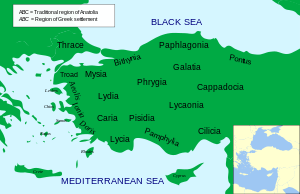Ionian Revolt
| Ionian Revolt | |||||||||
|---|---|---|---|---|---|---|---|---|---|
| Part of the Greco-Persian Wars | |||||||||
 Location of Ionia within Asia Minor |
|||||||||
|
|||||||||
| Belligerents | |||||||||
|
Ionia, Aeolis, Doris, Caria Athens, Eretria, Cyprus |
Persian Empire | ||||||||
| Commanders and leaders | |||||||||
|
Aristagoras, Charopinos, Hermophantus, Eualcides†, Melanthius Dionysius of Phocaea Histiaeus Hecataeus |
Megabates, Artaphernes, Daurises†, Hyamees, Otanes, Datis |
||||||||
The Ionian Revolt, and associated revolts in Aeolis, Doris, Cyprus and Caria, were military rebellions by several Greek regions of Asia Minor against Persian rule, lasting from 499 BC to 493 BC. At the heart of the rebellion was the dissatisfaction of the Greek cities of Asia Minor with the tyrants appointed by Persia to rule them, along with the individual actions of two Milesian tyrants, Histiaeus and Aristagoras. The cities of Ionia had been conquered by Persia around 540 BC, and thereafter were ruled by native tyrants, nominated by the Persian satrap in Sardis. In 499 BC, the then tyrant of Miletus, Aristagoras, launched a joint expedition with the Persian satrap Artaphernes to conquer Naxos, in an attempt to bolster his position. The mission was a debacle, and sensing his imminent removal as tyrant, Aristagoras chose to incite the whole of Ionia into rebellion against the Persian king Darius the Great.
In 498 BC, supported by troops from Athens and Eretria, the Ionians marched on, captured, and burnt Sardis. However, on their return journey to Ionia, they were followed by Persian troops, and decisively beaten at the Battle of Ephesus. This campaign was the only offensive action by the Ionians, who subsequently went on the defensive. The Persians responded in 497 BC with a three pronged attack aimed at recapturing the outlying areas of the rebellion, but the spread of the revolt to Caria meant that the largest army, under Daurises, relocated there. While initially campaigning successfully in Caria, this army was annihilated in an ambush at the Battle of Pedasus. This resulted in a stalemate for the rest of 496 BC and 495 BC.
...
Wikipedia
